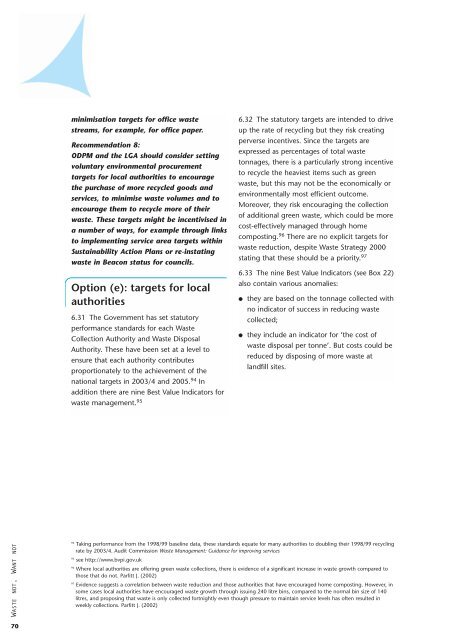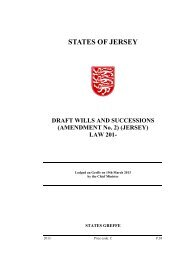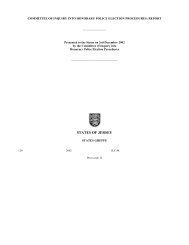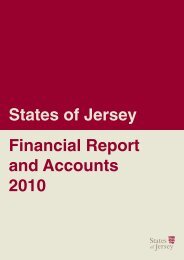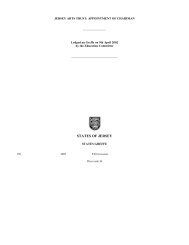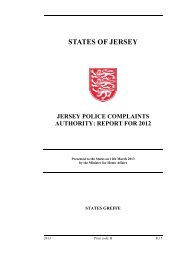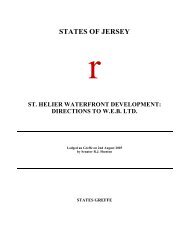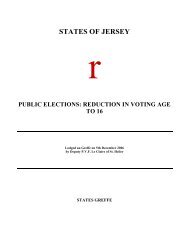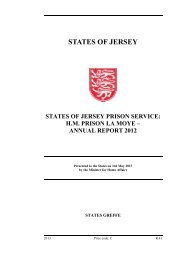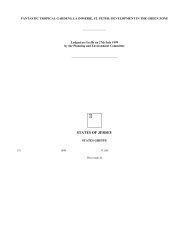Waste not want not - States Assembly
Waste not want not - States Assembly
Waste not want not - States Assembly
You also want an ePaper? Increase the reach of your titles
YUMPU automatically turns print PDFs into web optimized ePapers that Google loves.
minimisation targets for office waste<br />
streams, for example, for office paper.<br />
Recommendation 8:<br />
ODPM and the LGA should consider setting<br />
voluntary environmental procurement<br />
targets for local authorities to encourage<br />
the purchase of more recycled goods and<br />
services, to minimise waste volumes and to<br />
encourage them to recycle more of their<br />
waste. These targets might be incentivised in<br />
a number of ways, for example through links<br />
to implementing service area targets within<br />
Sustainability Action Plans or re-instating<br />
waste in Beacon status for councils.<br />
Option (e): targets for local<br />
authorities<br />
6.31 The Government has set statutory<br />
performance standards for each <strong>Waste</strong><br />
Collection Authority and <strong>Waste</strong> Disposal<br />
Authority. These have been set at a level to<br />
ensure that each authority contributes<br />
proportionately to the achievement of the<br />
national targets in 2003/4 and 2005. 94 In<br />
addition there are nine Best Value Indicators for<br />
waste management. 95<br />
6.32 The statutory targets are intended to drive<br />
up the rate of recycling but they risk creating<br />
perverse incentives. Since the targets are<br />
expressed as percentages of total waste<br />
tonnages, there is a particularly strong incentive<br />
to recycle the heaviest items such as green<br />
waste, but this may <strong>not</strong> be the economically or<br />
environmentally most efficient outcome.<br />
Moreover, they risk encouraging the collection<br />
of additional green waste, which could be more<br />
cost-effectively managed through home<br />
composting. 96 There are no explicit targets for<br />
waste reduction, despite <strong>Waste</strong> Strategy 2000<br />
stating that these should be a priority. 97<br />
6.33 The nine Best Value Indicators (see Box 22)<br />
also contain various anomalies:<br />
●<br />
●<br />
they are based on the tonnage collected with<br />
no indicator of success in reducing waste<br />
collected;<br />
they include an indicator for ‘the cost of<br />
waste disposal per tonne’. But costs could be<br />
reduced by disposing of more waste at<br />
landfill sites.<br />
WASTE NOT, WANT NOT<br />
94<br />
Taking performance from the 1998/99 baseline data, these standards equate for many authorities to doubling their 1998/99 recycling<br />
rate by 2003/4. Audit Commission <strong>Waste</strong> Management: Guidance for improving services<br />
95<br />
see http://www.bvpi.gov.uk<br />
96<br />
Where local authorities are offering green waste collections, there is evidence of a significant increase in waste growth compared to<br />
those that do <strong>not</strong>. Parfitt J. (2002)<br />
97<br />
Evidence suggests a correlation between waste reduction and those authorities that have encouraged home composting. However, in<br />
some cases local authorities have encouraged waste growth through issuing 240 litre bins, compared to the normal bin size of 140<br />
litres, and proposing that waste is only collected fortnightly even though pressure to maintain service levels has often resulted in<br />
weekly collections. Parfitt J. (2002)<br />
70


